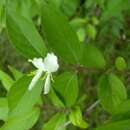en
names in breadcrumbs


Lonicera xylosteum, commonly known as fly honeysuckle,[1] European fly honeysuckle, dwarf honeysuckle[2] or fly woodbine is a deciduous shrub.[1]
The glossy red (or occasionally yellow) berries of this shrub are mildly poisonous to humans – children who ingest a large number (c. 30) of berries may experience abdominal pain and vomiting.[3]
 Lonicera xylosteum
Lonicera xylosteum Lonicera xylosteum, commonly known as fly honeysuckle, European fly honeysuckle, dwarf honeysuckle or fly woodbine is a deciduous shrub.
The glossy red (or occasionally yellow) berries of this shrub are mildly poisonous to humans – children who ingest a large number (c. 30) of berries may experience abdominal pain and vomiting.